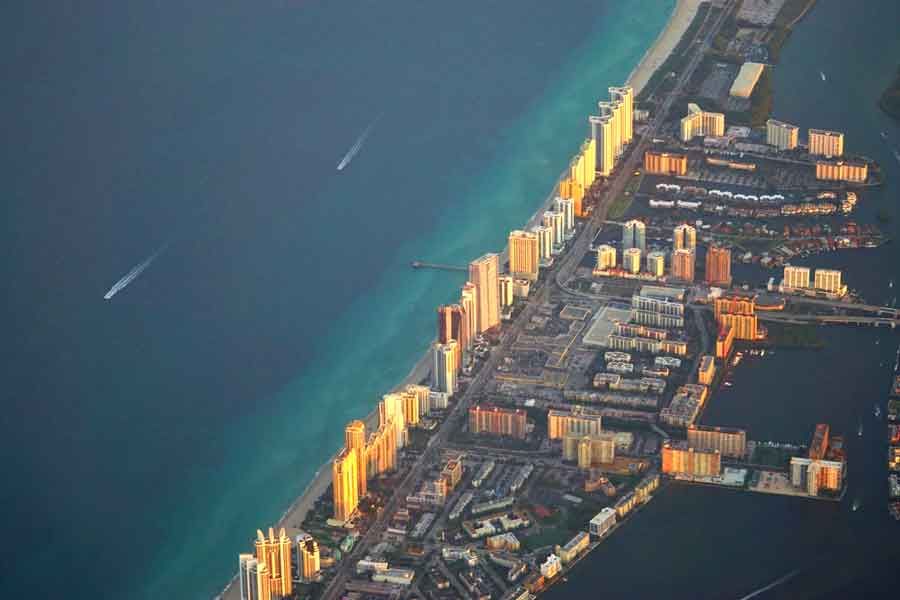Protect America’s border from climate change
By Dawn Stover | January 18, 2018

With a government shutdown looming, Congressional lawmakers are haggling over a potential bipartisan deal that would protect undocumented immigrants brought to the United States as children, while also beefing up security along the border with Mexico. While the proposed bipartisan bill does not call for the full-length physical barrier that President Donald Trump at times seems to want, it would require a mile-by-mile analysis of the border, with physical barriers to be erected where deemed necessary. That is a more common-sense approach than the president’s, but in fact, both Congress and the White House are focusing on the wrong boundary line. Trump says the US southern border is “very dangerous,” but a far bigger menace to the United States lurks along America’s extensive coastline. It is called climate change, and millions of American homes, businesses, and lives are at stake.
A vulnerable border. The US-Mexican border is 1,954 miles long. America’s “general” coastline is far longer: 12,479 miles. Measuring the shoreline using smaller-scale charts, and including features such as bays and offshore islands, brings the total to more than 88,000 miles, not including the Great Lakes. The shoreline of Florida alone is more than four times the length of the US-Mexican border.
Coastal counties are home to nearly 40 percent of the US population. With the exception of Alaska, these counties are five times as densely populated as the rest of the nation. “If the nation’s coastal counties were an individual country, it would rank third in the world in gross domestic product, surpassed only by the United States and China,” according to the National Oceanic and Atmospheric Administration (NOAA) Office for Coastal Management.
Coastal areas are also the most vulnerable to the impacts of climate change: rising sea level, shoreline erosion, flooding, contaminated drinking water, ocean acidification, harmful algal blooms, coral bleaching, and more. “By 2050, up to $106 billion worth of coastal property will likely be below sea level” if we continue with business as usual, says NOAA. “There is a 1-in-20 chance—twice as likely as an American developing melanoma—that by the end of this century, more than $1 trillion worth of coastal property will be below mean sea level or at risk of it during high tide.”
Projections say that “the majority of coastal communities will experience 30 days of tidal flooding annually by 2050.” With climate change intensifying the frequency and magnitude of extreme weather events, the average annual price tag for coastal storms is expected to grow by $7.3 billion to $35 billion. That is double the price tag of Trump’s absurdly expensive border wall.
A national security threat. The Coastal Zone Management Act, passed by Congress in 1972, already states that “because global warming may result in a substantial sea level rise with serious adverse effects in the coastal zone, coastal states must anticipate and plan for such an occurrence.” The Act also declares that it is national policy to encourage and assist states in developing programs that “minimize the loss of life and property…in areas likely to be affected by or vulnerable to sea level rise.” However, Trump’s proposed 2018 budget would slash funding for coastal management, research, and education.
Imagine if the United States decided to do a mile-by-mile analysis of its coastline, rather than its Mexican border, to figure out the best ways to adapt to climate change in different locations. Such a study would go a long way toward protecting vulnerable communities and important infrastructure—coastal military bases, for example.
On January 11, a bipartisan group of more than 100 members of Congress sent a letter to Trump, expressing concern that the president’s National Security Strategy, issued last month, fails to recognize climate change as a security threat to the United States. “As global temperatures become more volatile, sea levels rise, and landscapes change, our military installations and our communities are increasingly at risk of devastation,” the lawmakers wrote. Unfortunately, their voices are being drowned out by the loud debate over Trump’s demands for a border wall.
Lacking leadership on climate security at the federal level, cities are taking matters into their own hands. New York City announced last week that it plans to divest pension funds from fossil fuel investments, and to sue the world’s five largest investor-owned fossil fuel companies “for the billions of dollars the City will spend to protect New Yorkers from the effects of climate change.” Los Angeles might follow suit.
What are their chances of success? A lot better than Trump’s odds of getting Mexico to pay for his wall.
Together, we make the world safer.
The Bulletin elevates expert voices above the noise. But as an independent nonprofit organization, our operations depend on the support of readers like you. Help us continue to deliver quality journalism that holds leaders accountable. Your support of our work at any level is important. In return, we promise our coverage will be understandable, influential, vigilant, solution-oriented, and fair-minded. Together we can make a difference.
Topics: Climate Change, Columnists














